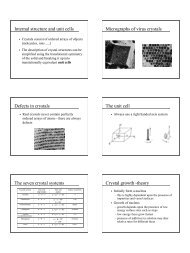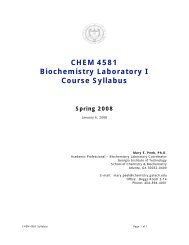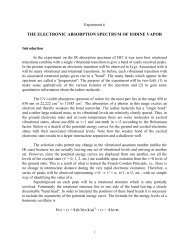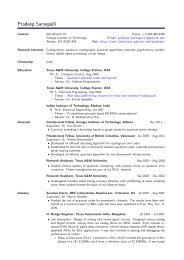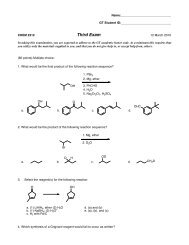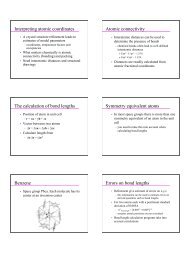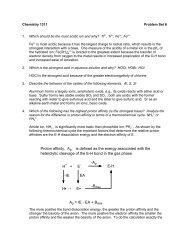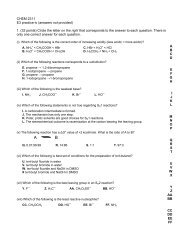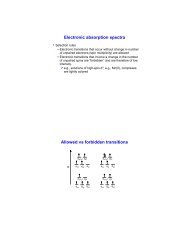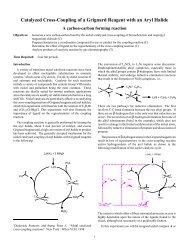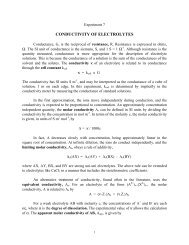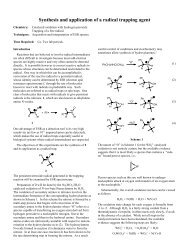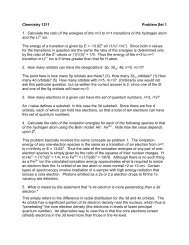II Alkanes, Alkenes, and Alkynes
II Alkanes, Alkenes, and Alkynes
II Alkanes, Alkenes, and Alkynes
- No tags were found...
You also want an ePaper? Increase the reach of your titles
YUMPU automatically turns print PDFs into web optimized ePapers that Google loves.
2.1.1 Isomers, Nomenclature, <strong>and</strong> Conformations of <strong>Alkanes</strong>Basic <strong>Alkanes</strong> ⇒ chain like molecules based on C <strong>and</strong> H with NO branchBranched <strong>Alkanes</strong>: <strong>Alkanes</strong> that have carbons that are bonded to more than 2carbons (these are skeletal isomers)Example Butane:Primary Carbon: Carbon bonded to only ONE other carbon (1°)Secondary Carbon: Carbon bonded to TWO other carbons (2°)Tertiary Carbon: Carbon bonded to THREE other carbons (3°)Quaternary Carbon: Carbon bonded to FOUR other carbons (4°)Nomenclature:⇒ parent: longest alkyl chain of the molecules→ if two possible chains have the same # of carbons, the onewith the more branch points wins⇒ suffix: If only alkane, ending is -ane; if molecule has functional groups, theydetermine the suffixAlkyl Group:Example:Hydrocarbon chain with one open point of attachmentoften R is used to describe a generic alkyl group2
Alkyl Groups:Examples of Nomenclature:3
Conformational Isomers: Isomers that differ as a result of the degree ofrotation around a carbon-carbon single bondLet us take Ethane as an example to describe alkane conformation:Conformation or orientations of alkanes can be expressed using several differentmethods:A) Sawshorse Diagram: A way of representing conformational isomers withstick drawingsB) Newman Projection: A way of representing conformational isomers usingan end-on projection of a carbon-carbon bondEclipsed: Conformation around a carbon-carbon single bond in which attachedatoms are as close together as possibleStaggered: Conformation around a carbon-carbon single bond in which attachedatoms are as far apart as possibleTorsional or Dihedral Angle: Angle between the bonds in the Newman Projection4
Example 1,2-Dibromoethane:Q1: Which of these structures is the most stable <strong>and</strong> why:Example Butane:- Staggered most stable.- Two possibilities, Anti <strong>and</strong> Gauche5
2.1.2 Cycloalkanes• Cyclic structure based on Carbon-Carbon single bondsFused Ring Systems: Several cycles (or rings) share two common atoms<strong>and</strong> the bond between themSpiro Compound:Two Rings share ONE carbonBridged Ring Compounds: Two rings share two non-connected atoms, therebybuilding a bridgehead with bridgehead atomsExamples:Nomenclature:6
Conformation of Cycloalkanes:Boat Confirmation: An unstable conformation of cyclohexane with 109.5° bondangles but in which most bonds are eclipsedExample:Chair Confirmation: The most stable conformation of cyclohexane in which allbonds are staggered <strong>and</strong> the bond angles are 109.5°Example:⇒ The hydrogens are either above <strong>and</strong> below the ring or to the side of the ringAxial Bond:Bond on cyclohexane chain perpendicular to the ring withthree up <strong>and</strong> three down on alternating carbonsEquatorial Bonds: Bonds on cyclohexane chair parallel to the ringCycloalkanes are not restricted to one confirmation but can FLIP betweendifferent conformations. This is called Ring Flip.7
Substituted CycloalkanesBulky substituents prefer to be in equatorial position <strong>and</strong> NOT axialExample Methylcyclohexane:Geometric Isomers:Cis <strong>and</strong> trans isomers; a type of stereoisomers in whichatoms or groups display orientation differences around a double bond or ringCis Isomer: Geometric isomer in which groups are on the same side of a ringor double bondTrans Isomer: Geometric Isomer in which groups are on the opposite sides of aring or double bondExample:8
2.1.3 Properties of <strong>Alkanes</strong>• Melting <strong>and</strong> boiling points increase with increased molecular weight (Methane bp.-164°C, decane bp. 174°C)• Boiling point decrease with chain branching (decrease in surface area) but metlingpoints increase• Non-polar substances ⇒ not water soluble• <strong>Alkanes</strong> are less dense than water <strong>and</strong> swim on top of water2.1.4 Reactions of <strong>Alkanes</strong>• In general very un-reactive ⇒ you need a lot of driving forceA) OxidationExample Methane:B) HalogenationHalogenation (a substitution reaction): Introduction of a halogen into a molecule(chlorination, bromination)General Reaction:• You need heat or light9
Example Methane:How to control the degree of halogenation?Mechanism:- same as free radical polymerizationWhere does halogenation takes place?10
Properties <strong>and</strong> nomenclature of haloalkanes• Toxic <strong>and</strong> cause cancer• Major component of free radicals in ozone layer• polar bond (partial charges)• Nomenclature same as basic alkane nomenclatureExamples:11
2.2 <strong>Alkenes</strong> <strong>and</strong> <strong>Alkynes</strong>• Alkene: Hydrocarbon with at least one carbon-carbon double bond (olefins)• <strong>Alkynes</strong>: Hydrocarbon with at least one carbon-carbon triple bondNomenclature:Examples:Classification based on substitution patterns:Monosubstituted:Disubstituted:Trisubstituted:Tetrasubstituted:12
• Properties of <strong>Alkenes</strong> <strong>and</strong> <strong>Alkynes</strong>- NO rotation around double <strong>and</strong> triple bonds- Similar to <strong>Alkanes</strong> (bp <strong>and</strong> mp)• Isomerismcis <strong>and</strong> trans:If you have four different substituents around a double bond cis/trans does not workE/Z Nomenclature:• Each substituent is assigned a priority• The substituent with the highest priority on each carbon is determined• If these substituents are on the same side of the molecule, the configuration is Z(zusammen (meaning together))• If these substituents are opposite from each other, the configuration is E(entgegen (meaning opposite))13
Examples:How to determine the group priorities?1) The greater the atomic number the higher the priority2) If the two substituents on an sp 2 carbon have the same atomic number (there is atie), the atomic numbers of the atoms that are attached to the "tied" atoms must beconsidered3) If an atom is doubly bonded to another atom, the priority system treats it as if itwere a singly bonded to two of these atoms4) In the case of isotopes, the mass number is used to determine the priorityExamples:14
2.2.1 Preparation of <strong>Alkenes</strong> <strong>and</strong> <strong>Alkynes</strong>• Elimination Reactions:Dehydrohalogenation: A reaction in which hydrogen <strong>and</strong> halogen are eliminatedfrom a moleculeExamples:Dehydration: A reaction in which the elements of water (H <strong>and</strong> OH) areeliminated from a moleculeExamples:15
Mechanism:What about the orientation of the double bond?Example:Zaitsev's Rule:(with alkyl groups) will predominateIn applicable elimination reactions, the most substituted alkeneStability:CH 2 CH 2 < RCHCH 2 < RCHCHR = R 2 CCH 2 < R 2 CCHR < R 2 CCR 2 (most stable)16
2.3 Reactions of <strong>Alkenes</strong> <strong>and</strong> <strong>Alkynes</strong>⇒ Additions are the most common reactions using alkenes <strong>and</strong> alkynesAddition to:AlkeneAlkyneFour major additions:1) Addition of hydrogen halides2) Halogenation: Reaction in which halogen is introduced into a molecule3) Hydration: Reaction in which the elements of water (H <strong>and</strong> OH) areintroduced into a molecule4) Hydrogenation: Reaction in which hydrogen is introduced into a molecule17
Examples:18
2.3.1 MechanismElectrophilic Addition: Addition reaction initiated by an electron-deficient species(electrophile)• Generic Mechanism:• Mechanism of Addition of Hydrogen Halides:19
• Mechanism for the Addition of Halogen• Mechanism for the Addition of Water:20
• Orientation of Addition:The more alkyl groups attached to carbocation, the more stable (3° > 2° > 1°)Markovnikov's Rule: When an unsymmetrical reagent adds to an unsymmetricalalkene, the positive portion of the reagent adds to the carbon that results in theformation of the more stable carbocationRegioselective: In addition reactions, a reaction in which one of two possiblepositional isomers predominatesRegiospecific: In addition reactions, a reaction in which one of two possiblepositional isomers is formed exclusivelyExamples:21
• Addition reactions in Polymer ChemistryPolymer:Monomer:A giant molecule composed of a repeating structural unitCompound(s) from which a polymer is madeExamples of Addition Polymers:- Polyethylene:- Polypropylene:- Polystyrene:- Polymethylmethacrylate (PMMA):- Orlon:- Teflon:22
- Polyvinylchloride- Polyvinylidine chlorideMechanism of the Cationic Polymerization:23
2.4 Oxidation Reactions of <strong>Alkenes</strong> <strong>and</strong> <strong>Alkynes</strong>1) Hydroxylation with Potassium Permanganate (KMnO 2 )Example:2) OzonolysisExample:24
2.5 Alkadienes (or Dienes)Alkadienes: Compounds containing two double bondConjugation: Alternating double <strong>and</strong> single bonds in a moleculeIsolated or Non-Conjugated Double Bond: Two double bonds separated bymore than one single bondAdditions:Allylic Carbocation:carbon-carbon double bondsCarbocation in which a positive carbon is adjacent to a25
Orbital considerations of allylic carbocations:• Important Dienes:1) Terpenes26
2) Rubber27
Summary of Chapter 2:<strong>Alkenes</strong>NomenclatureIsomersConformationCycloalkanesReactivity of <strong>Alkanes</strong>Properties of <strong>Alkanes</strong><strong>Alkenes</strong> <strong>and</strong> <strong>Alkynes</strong>NomenclatureIsomersPreparation of <strong>Alkenes</strong> <strong>and</strong> <strong>Alkynes</strong>Additions to <strong>Alkenes</strong> <strong>and</strong> <strong>Alkynes</strong>Electrophilic AdditionsHydrationHydrogenationHalogenationMechanisms <strong>and</strong> StereochemistryPolymerizationOxidations of <strong>Alkenes</strong> <strong>and</strong> <strong>Alkynes</strong>DienesReactions of DienesTerpenes <strong>and</strong> Rubber28




